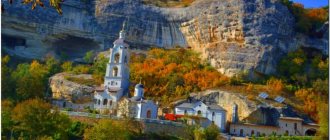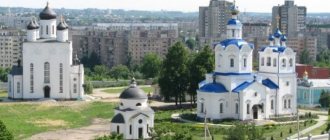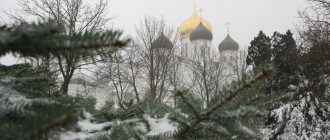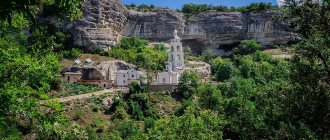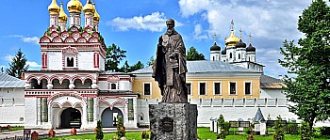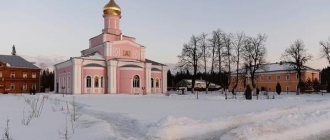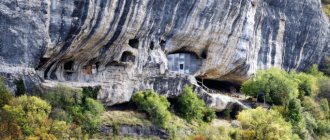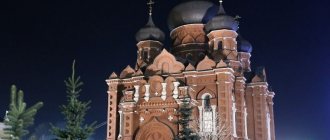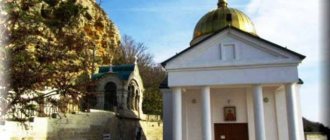Staraya Ladoga never ceases to amaze with its treasures. One of them is the Staraya Ladoga Holy Dormition Convent , where there is a cathedral in the name of the Dormition of the Blessed Virgin Mary , an architectural monument of the 12th century, one of the few churches of the pre-Mongol era that have survived in Russia. Evdokia Lopukhina, Evdokia Hannibal and the wives of the Decembrists were imprisoned within the walls of the monastery; in hard times, the blessed princess Anna Kashinskaya found shelter.
Panorama of the Holy Dormition Convent
Legends about the founding of the monastery
Reliable information about how and when the monastery was founded is unknown. There are many legends surrounding the history of the construction of the shrine. One of them tells about the shepherd Mikhail, who every day grazed a flock of sheep in the mountains. One day he saw a strange glow emanating from a cave near the pasture. Looking inside, the guy discovered the image of the Virgin Mary, shrouded in bright light. The shepherd brought the icon home, but the next morning it disappeared. Imagine his surprise when he saw her again in the same cave. The boy took the shrine with him again and history repeated itself. The residents of the village where Michael lived, who learned about this, interpreted the unusual incident as a divine sign, and soon together they built a cave temple at the site of the discovery of the Holy Face.
Holy Dormition Cave Monastery near Bakhchisarai
Another myth associated with the Holy Dormition Monastery speaks of an evil dragon who got into the habit of destroying young boys and girls. Desperate fellow villagers appealed to the Most Holy Theotokos, begging Her for deliverance from the bloodthirsty serpent. After some time, the tragic deaths stopped. The emboldened villagers climbed the mountain, where they found the defeated reptile, above whom the shining image of the Mother of God hovered. To honor the Heavenly Intercessor, they built a church in the rock, where they began to come to offer prayers of thanks.
The most plausible is the legend about the Greek monks who, during Christian persecution, moved to the Crimean peninsula. Looking for a new refuge, they were captivated by the beauty of the Maryam-dere gorge, so similar to their native places. There they built a temple, and soon founded a small settlement. Later, archaeologists discovered ancient burials on the territory of the monastery, dating back to the 6th century, which gave this version even more plausibility.
Church of the Assumption of the Blessed Virgin Mary
The Church of the Assumption of the Blessed Virgin Mary is the main architectural landmark of the monastery. This is a four-pillar, three-nave, three-apse, single-domed temple. The drum is crowned with a dome with a helmet-shaped head. A staircase in the western wall leads to the choir.
Cathedral of the Assumption of the Blessed Virgin Mary
The length of the temple is 18 meters, width - 14 meters, height - 19 meters. During the service, several dozen believers could be present here. It is believed that the cathedral was a tomb for representatives of the Rurik family, as evidenced by the presence of deep semi-circular arcosolium niches intended for burial.
Cross in the zakomar of the Assumption Cathedral
Among researchers there is no clear opinion regarding the customer and the exact time of construction of the temple. It probably stands on the site of an older wooden church. According to one version, its customer could have been Prince Mstislav the Great (1076-1132) or his wife, the Swedish princess Christina. According to another, their son, Prince Izyaslav (c. 1097-1154), as indicated by the princely castle discovered under the arches of the temple. Perhaps the construction of the cathedral began either simultaneously with the Staraya Ladoga fortress (1114-1116), or immediately after it.
Assumption Cathedral
In 1611-1617, the Assumption Monastery, like all of Ladoga, was devastated by the Swedes. However, already in 1617, immediately after the enemy left, the Assumption Cathedral was re-consecrated.
Extensions and alterations of the 18th-19th centuries significantly distorted the original appearance of the temple. In 1762, under Abbess Eupraxia, a stone bell tower was added to the western side of the temple, replacing the dilapidated wooden one. In 1802, instead of the previous wooden porch, a stone one was added to the Annunciation chapel. In 1829, the stone bell tower was built with a third tier, its height was 32 meters.
Spinning of the Assumption Cathedral
In 1831-1833, according to the design of the St. Petersburg architect A.I. Melnikov, the warm Annunciation chapel was rebuilt. As a result of these reconstructions, the cathedral, porch and bell tower formed a single volume. In 1854-56, the chapel of the Holy Great Martyr Barbara, built in the choir in the north-eastern part of the temple at the beginning of the 18th century, was redone. On the choir in the south-eastern part of the temple a new chapel appeared in the name of the Kazan Icon of the Mother of God. In 1855-56, stoves were installed in the previously cold Assumption Church, and it became warm. At the same time, a new iconostasis appeared, destroyed after the revolution.
During the restoration work of 1958-1960, the original volume of the Assumption Cathedral was freed from later additions. About 50 sq.m. were revealed. meters of frescoes of the 12th century - about 13 thousand fragments of painting on walls, pillars and in the slopes of window openings.
Fragments of the narthex
During the time that has passed since construction, the cultural layer has risen by several meters, and now the temple looks more squat than in ancient times. The Assumption Cathedral is the first among similar buildings in Staraya Ladoga. All other temples were built in his likeness.
Divine services in the Assumption Cathedral are held only in the summer. There are constant disputes between the Russian Orthodox Church and the Committee for State Control, Use and Protection of Historical and Cultural Monuments (KGIOP) regarding the proper operation of the cathedral.
Drum and dome of the Assumption Cathedral
Historical facts
Until the 13th century, the history of the Holy Dormition Monastery was shrouded in secrecy. Historians have been able to establish for certain that for a hundred years the monastery was inactive, but in the 14th century, with princely funding, it reopened its doors.
It is noteworthy that during the Mongol-Tatar raids, the Bakhchisarai shrine was able not only to survive, but even to become the residence of the Gothic and Kafa metropolitans. In addition, representatives of the khan dynasties regularly helped the monastery, providing it with candles.
When Crimea was captured by the Ottomans, the conquerors imposed a huge tax on the monastery, as a result of which it became sharply impoverished and fell into decay. It was liberated from the Turks only three centuries later through the efforts of the Russian army. However, the monks who inhabited the shrine were forced to leave their native walls. By order of the authorities, they went to the Azov region, where they founded the city of Mariupol.
Until the 13th century, the history of the Holy Dormition Monastery was shrouded in mystery.
Later, Konstantin Spirandi, a Greek priest, came to Maryam-dere and resumed services on the territory of the monastery.
Until the end of the 18th century, the Assumption Church was considered the main one, but after the construction of the parish church in Bakhchisarai, it began to lose its popularity.
In 1850, Archbishop Innocent of Kherson and Tauride began reviving the shrine. Having collected the required amount of donations, he began restoration work, which ordinary people gladly joined. Soon the monastery found a second life, and pilgrims called it Crimean Athos. Several Russian emperors also visited here, including Nicholas II and his wife Alexandra Fedorovna.
During the Crimean War, a military hospital was established on the territory of the monastery, and dead soldiers were buried in the local cemetery. Here you can also find the graves of soldiers killed in World War II.
Before the Bolsheviks came to power, the monastery significantly expanded its holdings and acquired numerous buildings. However, after the revolution it was closed, the monks serving there were shot, and the shrines were destroyed. When the war began, a hospital was re-established within the walls of the former monastery, and later a psychoneurological clinic was opened in its place.
Only after the transfer of Crimea to Ukraine did the Holy Dormition Monastery begin to be restored again. Under the leadership of Hieromonk Silouan, together with ordinary laymen, the monastery was brought back to life in a short time. Despite the fact that restoration work is still ongoing, the shrine is open to visitors all year round.
Abbots and governors
- Tryphon (1110 - 1127)
- Nikander (1127 - 1153)
- Misail (1153 - ?)
- Porfiry (? - 1164)
- Theodoret (1164 - 1193)
- Alexander (1193 - 1203)
- Irinarch (1203)
- Alexander (1203 - ?)
- Gerasim
- Simeon (? - 1220)
- Barsanuphius (1200 - ?)
- And she
- Nikandr
- Kirill
- Isaiah (? - 1240)
- Varlaam (1240 - ?)
- Leonid
- Filaret (? - 1272)
- Methodius
- Lavrentiy
- Anthony
- And she
- Theodosius
- Savva (? - 1283)
- Simeon (1283 - 1289)
- Barnabas (1289 - ?)
- Cyprian
- Hermann
- Joseph
- Arseny
- Bogolep
- Serapion (? - 1292)
- Dorotheus (1292 - 1304)
- Jacob (1304 - 1312)
- …..
- St. Herman of Kazan (1551 - 1553)
- Ignatius (1553 - 1559)
- St. Job of Moscow (1559 - 1571)
- …
- Pimen (1601 - 1607)
- St. Dionysius of Radonezh (1607 - 1610)
- …
- Methodius (1617 - 1623)
- Joseph (1623 - 1653)
- Leonid (1653 - 1655)
- Tikhon (1655 - 1658)
- Isaiah I (1658 - 1662)
- Varlaam (1662 - 1669)
- Sergius (1669 - 1672)
- Varlaam II (1672 - 1683)
- Isaiah II (1683 - 1697)
- Cornelius (1697 - 1716)
- Joachim (1716 - 1719)
- Melchizedek (1719 - 1722)
- Jonah (1722 - 1732)
- Tarasiy (1732 - 1769)
- Bartholomew (1763 - 1768)
- Philemon (1769 - 1770)
- Christopher (1770 - 1776)
- Macarius (1776 - 1783)
- Arseny (Moskvin) (1783 - 1784)
- Alexander (1784 - 1785)
- Amphilochius (1785 - 1785)
- Elpidifor (1785 - 1792)
- Pavel (1792 - 1795)
- Varlaam (1795 - 1796)
- Joasaph (Sretensky) (May 14, 1796 - 1798)
- Anastasy (1798 - 1806)
- Anthony (1806 - 1807)
- Ioannikiy (1807 - 1808)
- Sergius (1808 - 1808)
- Seraphim (1808 - 1811)
- Joasaph (1811 - 1816)
- Vladimir (1816 - 1818)
- Irenaeus (1818 - 1821)
- Innokenty (Alexandrov) (August 15, 1821 - August 2, 1823)
- Seraphim (1823 - 1824)
- Anthony (1824 - 1825)
- Macarius (1825 - 1832)
- Alexander (1832 - 1856)
- Theodore (1856 - 1858)
- Adrian (1858 - 1865)
- Methodius (1865 - 1866)
- Gabriel (1866 - 1867)
- Polycarp 1868 - 1871
- Mark (1871)
- Gabriel (1871 - 1884)
- Vitaly (1884)
- Agafangel (1884 - 1888)
- Arseny I (1888 - 1894)
- Alexy (1894)
- Arseny II (1894 - 1896)
- Nikolai (1896 - 1905)
- Tikhon (1905 - March 29, 1908 [1])
- Pavel (Krylov) (March 29, 1908 - August 25, 1918)
- Tikhon (1918 - ?)
- Alexy (? - 1923)
- Kirill (? - 1928)
- …
- Hermogenes (Chirkov) (1997 - October 12, 2007)
- Dimitry (Sevostyanov) (October 12, 2007 - July 9, 2019)
- Paisiy (Novozhenov) (from July 15, 2019), acting [2]
Holy Dormition Monastery today
Today, like hundreds of years ago, numerous steps carved into the rock lead to the cave monastery. The wall along which the staircase stretches is decorated with images of various holy places, under which you can see a small recess with earth brought from this shrine.
Climbing up, an incredible view of the Maryam-dere gorge opens up. From the upper platform you can see the entire territory of the shrine, including outbuildings located opposite, as well as the monastery vegetable gardens, laid out right on the mountain slopes.
In the main Assumption Church there is the famous icon of the Mother of God of the Three Hands, known for its miraculous powers. A consecrated spring flows nearby, and above it rises a small chapel with a mosaic image of the Blessed Virgin Mary. Pilgrims can collect holy water for free or buy it at the kiosk at the entrance.
The monks who built the monastery did the impossible - they erected the monastery buildings in such a way as to enhance the already excellent acoustics. During services, the voices of monks are heard throughout the gorge, and sometimes even reach the cave village of Chufut-Kale.
Numerous steps carved into the rock lead to the cave monastery.
ON THE TERRITORY OF THE MONASTERY IT IS PROHIBITED:
- enter residential fraternal buildings and outbuildings; — take photographs and/or video cameras of the clergy, brethren of the monastery, outbuildings, and also film inside churches; - pick flowers and grass, fruits from vegetable and fruit plants; — scatter food waste and other garbage; - walk on the slopes of the mountains located near the cave temple, the chalk pillars of the “Divas” (this is dangerous to health due to the presence of poisonous snakes and a possible fall on steep slopes). - make inscriptions on the walls of temples, caves and chalk pillars - “Divas”; - break the reverent silence with loud conversations, use foul language, smoke, or be under the influence of alcohol or drugs. Your vehicle can be parked in a designated parking lot.
How to get to the monastery
The easiest way to get to the Holy Dormition Monastery is by car. Leaving Bakhchisarai, follow Lenin and Rosa Luxemburg Street. When you reach Basenko, which crosses the main road, turn right. After a few hundred meters you will see souvenir shops - you can leave your car there. But then you have to walk 600 m, going up to the monastery.
There is also a bus route to the Assumption Monastery. Minibus No. 2 departs from the railway station and goes to the Staroselye stop. Coming out at the end, you will see a not very wide dirt road leading straight to the shrine. Walking along it will take a little more than a quarter of an hour.
Hikers can reach the monastery along a narrow path leading along caves and stone tombs. You will have to walk at a leisurely pace for about 30 minutes.
LiveInternetLiveInternet
Where Russia borders with Ukraine and Belarus, near the farm of the same name, in a picturesque area surrounded by forests, on the right, high and rocky bank of the River Snov, the Kamensky Assumption Monastery is located. Founded in 1681 by Elder Jonah Bolkhovsky, confessor of Hetman Semyon Samoilovich, at the expense of Hetman I. S. Mazepa, at that time a friend of the Russian throne, who allowed the monastery to occupy part of the Snovsky shore, which belonged to the Karpov lands. Monks began to flock to Hieromonk Jonah. Initially it was male, and in 1786 it was converted into female.
Under Samoilovich, the Kamensky monastery was very small, with 2-3 monks. The Kamensky monastery was finally established under Mazepa, in the universal of which it is written: “The venerable father Jonah, the builder of the newly built Kamensky monastery, informed us that in the Staradubsky regiment, near the Semyonovskaya settlement, on an empty island lying near the river Snov, and this island was called “Kamen” ", erected the foundation of the Church of the Assumption of the Blessed Virgin Mary and asked for immediate confirmation of the lands belonging to the monastery...". Mazepa granted the request of Jonah's father, issuing the given station wagon in December 1687. In addition, Mazepa gave personal funds to the monastery, as well as the village of Sushany, which previously belonged to Bishop Krezva, half of the village of Brovnichi, which previously belonged to Mikhail Rubts and the lands around the monastery itself, on which the monastery itself, with the permission of the hetman dated July 1, 1694, settled the village of Shumilovka and the village of Kamensky Khutor. In 1687, the Assumption Cathedral Church was built in the Kamensky Assumption Monastery. In 1697, a refectory church in honor of the Annunciation of the Virgin Mary was consecrated in the Kamensky Assumption Monastery. In 1775, the wooden Assumption Church of the Kamensky Assumption Monastery was sold to the village of Kurkovichi, and on April 20, 1776, the foundation stone of a new stone Assumption Cathedral took place in the Kamensky Assumption Monastery. Until the mid-18th century, all the buildings of the monastery: the Assumption Cathedral of 1687, the Church of the Annunciation with a refectory of 1697, the bell tower and the fence were wooden. In addition to the founder, Father Jonah, the following stood out: Irakli Komarovsky, later Bishop of Chernigov, and Joasaph Mitkevich (1754-1784). Stone construction began under Abbot Joasaph Mitkevich, when in 1753-58 the warm Church of the Nativity of John the Baptist with a refectory was built. In 1776-79, the extensive Assumption Cathedral was erected, followed by a hospital building and a stone fence, completed in the 1st half of the 1780s. The bell tower, which began at the same time, was dismantled and rebuilt in the 1850-60s. Of all these buildings, the cathedral and bell tower, as well as a small part of the fence walls, have survived to this day.
Under Razumovsky, half of the village of Brovnichy, donated by Ivan Mazepa to the Kamensky Monastery, was again annexed to the Ropsky volost.
In 1786, by decree of the Holy Synod, under Abbot Palladius Lukashevich, the Kamensky monastery was converted into a women's monastery, and the nuns of the then closed Pechenitsky monastery were transferred here from the outskirts of the city of Starodub. Written evidence of the nuns' lifestyle has been preserved. After the service in the church, having rested a little, they began doing chores around the monastery, doing handicrafts, teaching rural girls to read and write, and reading sacred books. All these classes were conducted in cells in strict silence.
According to the description of 1781, the Kamensky Monastery “is located on a flat, flat, low sandy place, on the right bank of the Snovi River, in the forest surrounding the monastery. There are 4 wooden churches in the fence, two of them are stone, one is large, the other is trapezoidal, and two are wooden. Wooden: the abbot's house has 4 chambers, and for the brethren in five connections, 18 chambers, with different barns and storerooms, and 10 servants' huts. A distillery with 7 boilers and a water mill with 5 boilers.” The main shrine of the Kamensky Holy Dormition Monastery, which attracted pilgrims from surrounding villages and pilgrims from afar, was the miraculous Novodvorsk Icon of the Mother of God. In its original form, it was written by St. Peter the Wonderworker, Metropolitan of Kyiv and All Russia at the beginning of the 14th century. While still an unknown monk, he became familiar with icon painting, and having retired to a deserted area in Volyn, not far from the city of Pinsk, in a now abolished monastery, built on the banks of the Rati River, in the New Palace tract, he founded the Novodvorsky monastery, where he painted the icon of the Mother of God. The Novodvorskaya monastery was captured by the Uniates, hieromonk Jacob transferred this icon to the Chernigov Dormition Eletsky Monastery. When the Surazhetsky monastery was founded in the Chernigov province, near the city of Surazh, the Right Reverend Anthony Stakhovsky gave the Novodvorsk icon as a blessing to the builder of the monastery, Simeon. In this monastery the image was placed in the cathedral church. In 1677, on August 14, the Belarusian Bishop Theodosius Vasilyevich, in a procession before the liturgy, transferred the Novodvorskaya icon from the old cathedral monastery church to the newly created church of the same Surazhetsky monastery. Saint Demetrius of Rostov, who was at this celebration, says that in the church after the liturgy on August 16, Nicodemus, abbot of Tsepersky, announced the miracles that took place during the procession of the cross from the icon of the Mother of God... Archbishop of Chernigov Lazar Baranovich, whom Saint Demetrius of Rostov called “the great pillar of the church,” loved to visit the Novodvorsky Monastery and pray in front of her. Her exact list was made especially for him. It was with this icon from his cell that Archbishop Lazar blessed Hieromonk Jonah.
A particularly revered copy of the Novodvorsky icon was located in the Kamensky Assumption Convent in the Novozybkovsky district of the Chernigov province. Chernigov Archbishop Lazar (Baranovich) gave his cell Novodvorsk Icon of the Mother of God as a blessing to the newly built monastery. The image, at the request of the saint, was copied from the icon of St. Metropolitan Peter... The grace of God, resting on the Kamensk monastery, deigned to glorify the Novodvorsky image as a sign of the special intercession of the Lady and Her favor to this monastery.
In the mid-1800s, there were 300 people in the monastery.
In 1889, on June 26, a strong thunderstorm broke out over the Kamensky Monastery, accompanied by deafening thunder and dazzling lightning. A lightning strike struck with particular force over the dome of the Assumption Church of this monastery. The high peak of the temple was instantly engulfed in flames. At that time, an akathist was performed in the church before the miraculous Novodvorskaya icon. When the thunderclap followed, everyone present in the church was amazed at the extraordinary event. The fiery flame of lightning descended along the chain of the chandelier from the top of the temple, then headed towards the icon of the Dormition of the Mother of God located above the royal doors. The image was turned into splinters by the force of the blow. From the royal gates, a lightning strike headed towards the Novodvorskaya Icon of the Mother of God. The priest standing in front of the image was showered with fiery sparks, and the veil in front of the image was completely burned by fire. And here the special favor of the Lady towards Her most pure image was revealed. The latter, to the surprise of all those present, was not at all damaged by either blow or flame. Then the blow, as if pushed away from the image by an invisible force, was directed at the massive thick wall of the temple and rushed out of the temple with such force that those standing in the temple, coming to their senses from amazement, saw a huge hole in the wall from the lightning explosion. Meanwhile, the fire in the dome continued. The nuns of the monastery looked in helpless despair and with great tears as the fiery element spread more and more. The significant height of the dome made it impossible to use anything to protect the church from the flames. But Divine favor and the heavenly protection of the Lady saved the monastery from disaster. As if by the wave of some invisible hand fanning the flames, the wind died down, silence fell, and the fire began to gradually decrease until it completely died out. All who were present at this wonderful event saw in everything that happened a clear sign of the patronage of the Most Holy Theotokos.
On June 9, 1847, Nicholas I approved the project for the reconstruction of the warm church in the name of John the Baptist and the bell tower in the Kamensky Assumption Monastery. The ashes of the landowner, wife of the Collegiate Assessor Tatyana Grigorievna Malakhova, née Tutkevich, are buried here.
The Kamensky Holy Dormition Monastery existed for 247 years. In 1928, by decision of the Bryansk provincial executive committee, dated October 15, 1928, the Kamensky Assumption Monastery was closed. Gradually, the stone buildings and fences began to be dismantled for the needs of Novozybkov and other significant objects.
Nowadays, people often come to the place where the remains of the monastery are preserved. Near the Snov River and a spring with healing spring water, a small chapel was built, which became a place of visit for many residents of the Klimovsky district and nearby Ukrainian villages.
In 2003, the face of the Mother of God appeared in the dilapidated chapel of the monastery. Several years ago, a huge fresco with the face of the Mother of God appeared on the wall of the bell tower. This image is a copy of the miraculous icon of the Novodvorskaya Mother of God, once kept in the monastery, donated to the monastery at its founding by Chernigov Archbishop Lazar Baranovich, the same one who once imposed an “anathema” on Starodub. The place where the fresco miraculously appeared was previously the main entrance to the monastery. Today, storks build nests on the ruins of the monastery’s Assumption Cathedral, and the territory of the former monastery belongs to the Kamensko-Khutorskoye Village Council. On the territory of the monastery itself is the village of Zabrama. In the center of the village, in the thickets of fruit trees, several red brick buildings can be seen. This is all that remains of the once rich monastery. And this clearly could not have happened without human intervention. The guards said that the bricks for building the farm in the village of Kamensky Khutor were taken from the monastery fence. Huge cracks in the foundation could not form on their own. Now they are filled with rocks in several places. In the area, stone boulders protruding from the surface, as if specially chipped, are not uncommon. Although where they could have come from in the Bryansk region is another mystery. Here and there you can see white plaster on the walls of the cathedral. The cathedral has not been in use for a long time, it stands as a ruin without doors. In the center, local residents organized something like an iconostasis. And here is the bell tower itself, the wooden doors of which are closed with an iron bolt, but anyone can easily open it. If you go inside the cathedral, the first thing that catches your eye is the famous fresco with the face of the Mother of God, the fame of which goes far beyond the borders of our region. It is interesting that in the academic corpus of monuments of the Bryansk region, where there is a description of fragments of paintings in Bryansk churches, there is not the slightest mention of the existence of this fresco. The remaining three walls are empty with large cracks in the whitewash. The fresco catches the eye with a bright blue spot. In the center, at a height of three meters, is the figure of the Mother of God with the Child, surrounded by six angels. According to rumors, the face of the Most Pure Virgin and the background around it appear more and more brightly every year. This is another mystery of the ruins of the Kamensky Monastery. Below you can see the figures of the suffering, whom angels lead to the Mother of God floating in the air, surrounded by cherubs. An unkind hand carefully wiped their eyes, and now they look reproachfully with empty eye sockets at the desolation of the monastery. Now people are flocking to the bell tower. Mostly women. With candles, icons, embroidered towels. They say that Our Lady of Kamensk, as the image is called, helps save families, heals sick children, and protects military relatives.
From the memoirs of a resident of the village of Zabrama:
— I came to Zabrama in 1948. - says Baba Dunya, the only living soul in Zabram at the time of our arrival. — The monastery was destroyed before the war. But an artist lived with us and gave me a picture of what this monastery used to look like. I remember there was still a warm church here. After the war, orphans lived in it and in the cathedral. The woman was watching them. And in 1954 the church caught fire. They said it was from soot and the firebox. But later it turned out that there was a shortage of children’s linen and the people looking after the children started the fire themselves. This happened in winter. The frost was terrible. What were the firefighters like back then? By the time they brought the barrel of water on horseback, it had already frozen... In general, the iron roof was somehow torn off and the fire was extinguished. The children were sheltered in neighbors and monasteries. The collective farm dismantled the brick walls into sheds, and the local residents stole whatever they could. They threw off three meters of earth to get one stone! They later opened a store in the chapel, selling kerosene. But not for very long. The roof was no longer there. One day storks settled there. The nest has been built. The locals rejoiced - the birds brought happiness. Our village had grown by that time: a house at home. Between the houses there are only thin paths and flower beds. Our men decided to repair the bell tower, they collected money from the people, whoever would give how much. I donated a hundred rubles. But it just didn’t work out. They climbed up, looked, spat and didn’t do anything... They only scared away the storks! And soon the icon appeared on the wall. It was covered with lime. Old-timers recall that an Orthodox priest from Ukraine, Arseniy, showed up in the village. He gathered the villagers and invited them to see the bell tower. The locals disagreed for a long time: they have lived in Zabram all their lives, they know every stone. But he insisted, saying that the nun had a prophetic dream. It was as if the face of the Mother of God appeared in the chapel of an abandoned monastery. And when the people entered the chapel, they couldn’t believe their eyes for a long time: The image of the Blessed Virgin was really visible on the wall. The news of the appearance of the holy face in Zabram quickly spread throughout the area. Lines of sick and suffering people poured into the bell tower with the hope of a miraculous healing. Knowledgeable people said that the “Our Lady of Kamensk” heals sick children, helps save families and protects military relatives. It’s a wonderful thing: there is no roof on the bell tower, and rain and wind do not enter it. To repair it - you give up, everything is old and rotten, but how many years it lasts! In this holy place, warning miracles also happen. Old-timers said that before the Great Patriotic War they heard a funeral bell from the chapel. You may not believe me, but several years ago I also heard this ringing. When our people, one by one, began to die because of the burner. Yes, all young men! Apparently, we will no longer survive this war... Maybe this is the punishment for not preserving the shrine? Description of the monastery: the architectural ensemble of the monastery is mainly designed in the Ukrainian Baroque style, despite the losses, it is an interesting monument of Bryansk architecture. The territory in plan had the shape of an irregular quadrangle, stretched from the river to the village. In the center of the northwestern wall of the fence facing it was the main entrance to the monastery with a gate bell tower. The compositional center of the ensemble, the Cathedral of the Assumption, placed on the longitudinal axis of the complex, dominated the rest of the buildings. To the northeast of it there was a warm refectory temple. These main structures with vertically developed volumes were clearly visible from behind the low walls and created a picturesque and expressive silhouette of the monastery. Inside, along the walls there were stone and wooden cells, the abbot's house and other buildings.
Fence: a typical example of monastery fences of the 2nd half of the 18th - mid-19th centuries. It has been preserved in fragments - two small spindles on the sides of the bell tower. The low - 3.5-4 meters - brick wall without towers on the outside was dissected by blades into separate spindles. The upper part, separated by a shelf, was cut through with arched openings like loopholes - nine openings in each spindle and one in the shoulder blades. A gable iron roof formerly rose above the final three-stage cornice. The parts of the walls adjacent to the bell tower were higher, they were crowned with small tents with domes on slender necks.
Assumption Cathedral: one of the wonderful churches of the 2nd half of the 18th century in the Bryansk region in the style of magnificent Ukrainian Baroque. The monumental building is constructed of brick on a foundation of local stone and is plastered inside and out. Renovated in 1889 after being damaged by lightning. To date, part of the altar, the roof and the dome with the dome have been lost. The cathedral belongs to the type of cruciform, single-domed temples characteristic of the architecture of Left Bank Ukraine in the late 17th and early 18th centuries. The main volume is formed by four powerful pentagonal arms in two lights, the middle cross of which is crowned with a high light octagon. The centricity of the overall structure is disrupted by the small, reduced volumes of the deacon and altar on the sides of the altar in the form of side apses ending in semicircles. The shaped roofs of the arms (their original pediments with the crowning drums of slender cupolas have been preserved) and the typically Ukrainian pear-shaped octagonal dome added picturesqueness and expressiveness to the completion. The elegant Baroque decor of the facades consists of peculiar rusticated blades with paneled niches covering the corners of the volumes, powerful semi-columns between the arms of the cross, wide entablatures and elaborate figured pediments above the pentagons, decorated with arched niches in the tympanums. At the bottom of the walls there are large arched niches with simple frames, interpreted as false windows; above them there are arched windows enclosed in lush frames with semi-columns on the sides and triangular pediments, complemented at the bottom and top with plaster rosette circles. Portals in the arms of the cross with beveled upper corners and paneled niches on the sides are also typical for Ukrainian architecture. A similar decor of the octagon, cut through by arched windows, is enhanced by the diamond rustication of the corner blades and triangles in the frieze of the entablature. The plaster finishing of the facades of the mid-19th century gives all the details excessive dryness and crushedness. In the interior, the high pentagonal arms of the cross are covered with closed vaults with strippings. They are completely open to the central square part of the temple, forming a single space that is highly developed in height. The girth arches of the sleeves, resting on corner pylons with cut off internal corners, support octagons with a closed arch using flat sails. Numerous windows in the upper part of the arms and the octagon saturate the huge room of the temple with light. The altar and the dia-horse, which have box vaults with conchs, are connected by openings in the side walls to the altar. The cathedral housed the miraculous icon of the Novodvorskaya Mother of God, donated to the monastery at its founding by Chernigov Archbishop Lazar Baranovich.
Tips for visiting the monastery
The Holy Dormition Monastery is an Orthodox shrine, and therefore one should behave on its territory in accordance with the church charter. A few rules to help avoid unpleasant situations:
- Photography or video shooting is prohibited;
- mobile phones should be switched to silent mode or turned off;
- women must cover their heads and wear modest attire.
You can take memorable photos only with the permission of the abbot and pay a symbolic donation to the monastery.
Author's advice
You can stay for several days in the guest house, which is located here. At the same time, food and accommodation are free. In return, the pilgrim is required to help with the housework, as well as adherence to local regulations.
Video filming is prohibited on site
Mobile phones should be turned off
A woman must cover her head before entering
The Holy Dormition Monastery is a picturesque place among the Crimean mountains, where pilgrims from all over Russia strive to get to. People come here to look at the local beauty, pray to the miraculous icon and simply pay tribute to the great history of this shrine.
If you find an error, please select a piece of text and press Ctrl+Enter.
